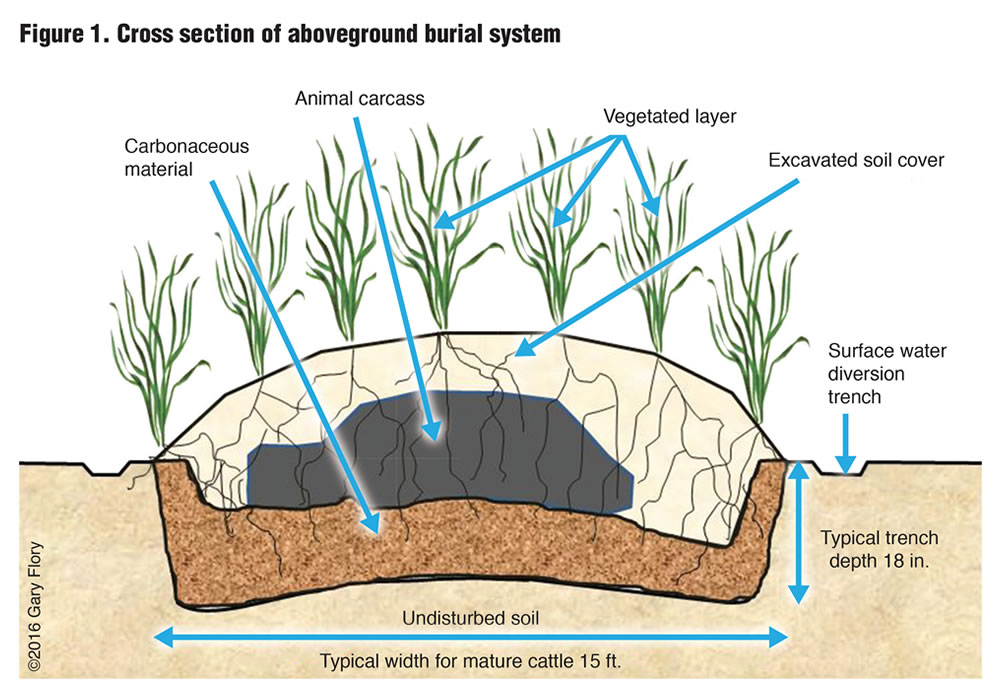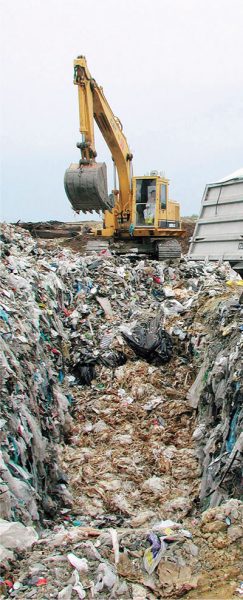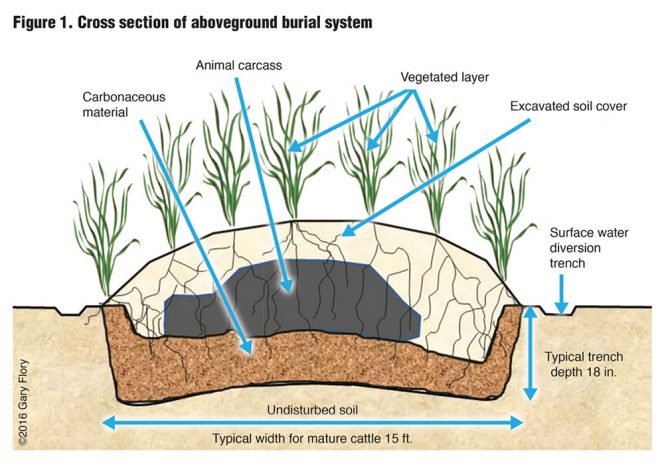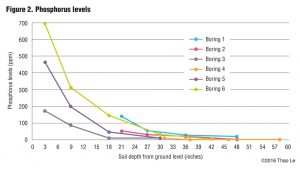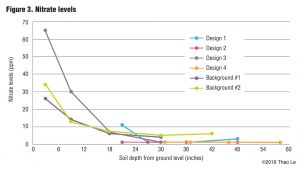MSPC offers many of the benefits of traditional on-site burial while minimizing the potential for environmental impact.
Gary Flory and Robert Peer
BioCycle March/April 2017
Outbreaks in the United Kingdom in 2001, and Japan and South Korea in 2010, are clear reminders that carcass disposal is a critical component of an effective disease response strategy. Dramatic photos of cattle burning in open pyres during the 2001 outbreak in the United Kingdom resulted in widespread public opposition to open burning. In Japan the lack of acceptable burial sites resulted in delays in disease eradication efforts and required the Japanese government to implement a vaccinate-to-kill strategy. This strategy, while helpful in limiting the spread of the disease, required the additional expenditure of already limited resources. Delays in eradication efforts may result in increased case detections and economic impact. A recent study of a simulated FMD outbreak in California concluded that delaying the response to an infection detection from 7 days to 22 days increased the mean number of herds under quarantine from 680 to 6,200, and increased the estimated economic impact of this simulated outbreak from $2.3 billion to $69 billion.
A study published in 2001 by the United Kingdom Department of Health looked at the potential health impact of various carcass disposal methods. It looked at the specific hazards present during FMD carcass disposal efforts and the associated pathways for human exposure. Burial was ranked as the highest risk disposal method with rendering posing the least risk. Potential hazards associated with burial include exposure to pathogens such as Campylobacter, E. coli, Listeria, Salmonella B, anthracis, Cryptosporidium, Giardia, Clostridium tetani, C. botulinum, Leptospira, Mycobacterium, tuberculosis v. bovis, Yersinia, prions for bovine spongiform encephalopathy (BSE), Scrapie, disinfectants, detergents, and hydrogen sulfide.
Pathways of exposure to these hazards include: direct contact, recreational water use, water supplies, crops, shellfish, contact with contaminated soil, migration into buildings, and inhalation. Landfilling of infected carcasses was assessed as lower risk but included similar potential exposure hazards and pathways. Hazards of open burning include particulates, sulfer dioxide (SO2), nitrous oxides, fuel-specific chemicals, metal salts, polycyclic aromatic hydrocarbons (PAHs), dioxins, prions for BSE, and Scrapie. Open burning pathways of exposure include water supplies, runoff, inhalation and deposition into the food chain.
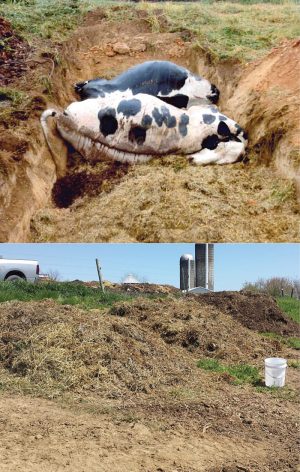
Carcasses placed on carbon layer in shallow trench (top). Completed installation of mesophillic static pile composting system. ©2016 Gary Flory
Project Purpose
Disposal methods have advanced little in the decade since the 2001 FMD outbreak in the United Kingdom. A disease outbreak today will be managed with the same techniques used in previous decades and will likely result in the same economic, health and environmental impacts. Now, more than ever, first responders need new options for disposing of carcasses.
The purpose of this research project conducted by the authors was to evaluate mesophilic static pile composting (MSPC) as an alternative to traditional burial methods. Traditional thermophilic composting, rendering and landfilling are all acceptable carcass disposal methods but during a large outbreak, additional options may be needed.
Traditional on-site burial entails excavating a pit 8 to 12 feet deep, placing a single or multiple layers of carcasses in the pit, and capping the pit with 2 to 3 feet of excavated soil. The final elevation of a burial pit is level with the ground surface. This process does not provide a suitable environment for biological decomposition, requires equipment not typically available on a farm and places decomposition fluids closer to the groundwater table. Traditional burial is considered a permanent disposal method which may require deed recordation and groundwater monitoring.
MSPC (also referred to as above-ground burial) offers many of the benefits of traditional on-site burial while minimizing the potential for environmental impact. Some potential benefits include:
• Simple, low technology design allows implementation with minimal training
• Low execution cost and relatively rapid to install
• Shallow trench depth and carbon layer to absorb decomposition fluids minimize environmental impacts and allow implementation in more diverse geologic settings
• Reduces potential for disease spread by keeping carcasses on the infected farm and minimizing need for external inputs
• Flexibility to implement as a temporary or permanent solution
• Carcasses could be excavated for permanent disposal (incineration, landfilling, composting) after initial disease eradication
• Aboveground burial mounds could be regraded and revegetated after complete carcass decomposition
• Can be implemented to manage carcasses during a natural disaster or foreign animal disease outbreak
Comparing Composting Methods
Traditional thermophilic composting and MSPC are similar in that both methods rely on aerobic biological activity to decompose the animal carcasses. MSPC occurs in a shallow trench within the biologically active soil zone (Figure 1). Biological activity is enhanced by the addition of a carbon layer similar to composting. Increasing the depth of the trench by only a few inches reduces the amount of oxygen available for biological activity and significantly decreases the speed of carcass decomposition.
Unlike thermophilic composting, MSPC does not promote the activity of thermophilic bacteria and does not generate the high temperatures that are achieved during windrow composting. As a result, pathogen inactivation does not occur from heat treatment but as a factor of time and the absence of a live host.
While thermophilic composting may be advantageous in many circumstances, during the response to an extremely contagious disease such as FMD, MSPC can be implemented more quickly to minimize the aerosolization of virus particles, reducing the potential for the spread of disease.
Technical Approach
The system designs assessed includes a shallow trench excavated into native soil to a depth of between 18 and 28 inches. Eight inches of loose soil or carbonaceous material are placed on the bottom of the trench followed by a single layer of animal carcasses. Excavated soils are subsequently placed back into the trench forming a mound on which the phytoremediation vegetative layer is established. Finally, a perimeter trench is placed around the mound to prevent the intrusion of surface water into the system.
Four variations of the MSPC system were evaluated. The designs are summarized in Table 1.
The surfaces of the MSPC mounds were monitored frequently to look for discharges and to assess plant growth and other changes to the systems. On May 14, 2015 the following observations were made:
• Cracks had formed on the surfaces of Designs 1 and 2 partially exposing the carcasses at the cracks.
• Minimal odor was observed from the cracks.
• No flies were observed.
• Total height on all designs had decreased 6 to 8 inches.
• Cool season grasses were well established but warm season grasses had not germinated.
• No leachate or free liquids were observed.
Soils from various depths beneath each design and in two background locations were sampled and analyzed for nutrients to assess the vertical migration of nutrients into the soil profile. Phosphorus levels (Figure 2) decreased with depth and were consistent with the background samples. These results were expected based on typical phosphorus movement through the soil profile. Like phosphorus, nitrogen concentrations (Figure 3) decreased significantly in the first 24 inches below the bottom of each trench. Nitrogen components, which are typically more mobile than phosphorus in soil, were not present in significant concentrations at depths of greater than 24 inches below the bottom of each trench.
MSPC Benefits
MSPC appears to offer many benefits over traditional burial pits during catastrophic large animal mortality events such as disease outbreaks and natural disasters. Although the use of landfilling and thermophilic composting is increasing for large animals such as cattle and swine, MSPC may be an option where these methods are not available and traditional burial is being considered, but to ensure adequate environmental protection, siting considerations such a soil characteristics, volume of animal carcasses and the depth to the seasonal high groundwater table should be considered before selecting aboveground burial as the disposal method. Studies conducted to date suggest that MSPC is a simple, low technology methodology that offers greater environmental protection than traditional burial methods.
Gary Flory is the Agricultural Program Manager for the Virginia Department of Environmental Quality and an independent global consultant, trainer and speaker in the areas of foreign animal disease response, counter-agroterrorism, One-Health, and animal carcass disposal. Robert Peer is the Agricultural Program Coordinator for the Virginia Department of Environmental Quality and composting Subject Matter Expert and consultant on animal carcass disposal.



